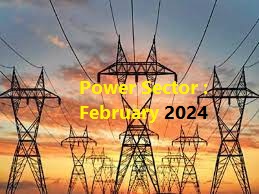Unprecedented increase in energy requirements of the country.
India’s electricity consumption climbed by 8% over the previous year in February 2024, hitting 127.79 billion units (BU). The month’s peak demand was 222GW, a record for February. The longer winter season in Northern India has increased the use of geysers and heaters, resulting in higher power consumption. Power exchanges recorded a trade of 9462 MU, which is more than 15% higher than the previous year.
Rules and Regulations
The Central Electricity Regulatory Commission has issued the CERC Tariff Terms and Conditions for 2024-29. It has kept the return on equity (ROE) for all thermal and hydroelectric power facilities. However, the figure has been raised to 17% for new hydroelectric power plants with reservoirs by adding 50 basis points. The CEA authorised the power exchanges to oversee their activities to assure compliance with the CERC (Power Market Regulations).
Electricity (Rights of consumers) Rules Amended.
The Electricity (Rights of Consumers) Rules, 2020, have been revised to allow for speedier installation of rooftop solar PV systems, including exemptions for technical feasibility studies for systems up to 10 kW and a shorter schedule for systems with larger capacities.
For rooftop solar PV installations up to 5 kW, the distribution licensee must now improve the systems at its own expense. Separate connections for electric vehicle charging stations have been implemented, in line with the country’s objective of lowering carbon emissions and attaining net zero by 2070. The period required to secure new electrical connections has decreased urban regions, municipal as well as in rural areas considerably.
Consumers in residential colonies and flats now have more options, including individual connections for everyone or a single-point connection for the entire premises. Metering, invoicing, and collection will be done separately for individual electrical usage, residential association backup power, and shared spaces. A mandatory Additional Meter in cases of Complaints about self-usage is also introduced. (The Electricity (Rights of Consumers) Amendment Rules, 2024)
12th Edition of the Integrated Rating of Discoms
The 12th edition of the Integrated Rating of Discoms in India has been announced. 14 out of 55 distribution companies obtain an A+ grade; state utilities of Gujarat, Haryana, Karnataka, Madhya Pradesh, and Andhra Pradesh are in the A+ / A category. It has been noted that Discom AT&C losses have decreased and are on a declining trend. The billing efficiency has increased, and the collection efficiency is already excellent. The goal of deploying smart prepayment metering is to enhance these efficiencies to 100%, which will also ensure that the AT&C losses of Discoms, including power theft, come down to single digits. In addition, two private utilities, TPNODL (Odisha) and DNHDDPDCL (Dadar, Nagar & Haveli, Daman & Diu), have obtained A+ ratings. The top positions go to Adani Electricity Mumbai Ltd. (AEML) of Maharashtra at first position, followed by Torrent Power Surat of Gujarat, Torrent Power Ahmedabad of Gujarat, Dakshin Gujarat Vij Company Limited (DGVCL) and Uttar Gujarat Vij Company Limited (UGVCL).
What’s happening in the Indian power sector?
The government has just released PM Surya Ghar Muft Bijli Yojana. In this scheme announced by the Hon’ble Prime Minister Narendra Modi, a campaign has been started to install solar panels in 1 crore houses of the country to save middle and poor-class families from expensive electricity bills. This will promote the Green Energy Mission and will also create new employment opportunities.
India Grid Trust (IndiGrid) has received a letter of intent from Gujarat Urja Vikas Nigam Ltd (GUVNL) to design, supply, test, construct, commission, operate, and maintain a 180 MW/360 MWh battery energy storage system (BESS) in Gujarat. This project is part of a greater 250 MW / 500 MWh BESS planned by GUVNL to increase Gujarat’s overall energy storage capacity and deliver renewable energy (RE) during peak and off-peak hours. The project was granted under the tariff-based competitive bidding (TBCB) procedure and will be established on a build, own, and operate (BOO) basis for 12 years.
Coal India Limited (CIL) today signed a Memorandum of Understanding (MoU) with Rajasthan Rajya Vidyut Utpadan Nigam Limited (RRVUNL) to explore and execute 4,100 MW capacity power projects, expanding its business diversification portfolio into thermal and renewable power generation. The planned energy-generating method would include a combination of coal-fired thermal power plants, solar projects, pump storage plants, and wind projects. The state of Rajasthan is examining numerous options for obtaining power to satisfy rising energy demand, and the state will buy the full generation.
Hero Future Energies, a renewable energy company, won a 120 MW capacity at a final tariff of INR 5.59 per kWh in SECI’s reverse auction. The business plans to connect 1500 MW of solar energy to the national grid across Punjab and Madhya Pradesh. JSW Neo Energy Limited, Serentica Renewables India Private Limited, and ReNew Solar Power Private Limited all took part in the auction. (Tamperfinder)












Add comment